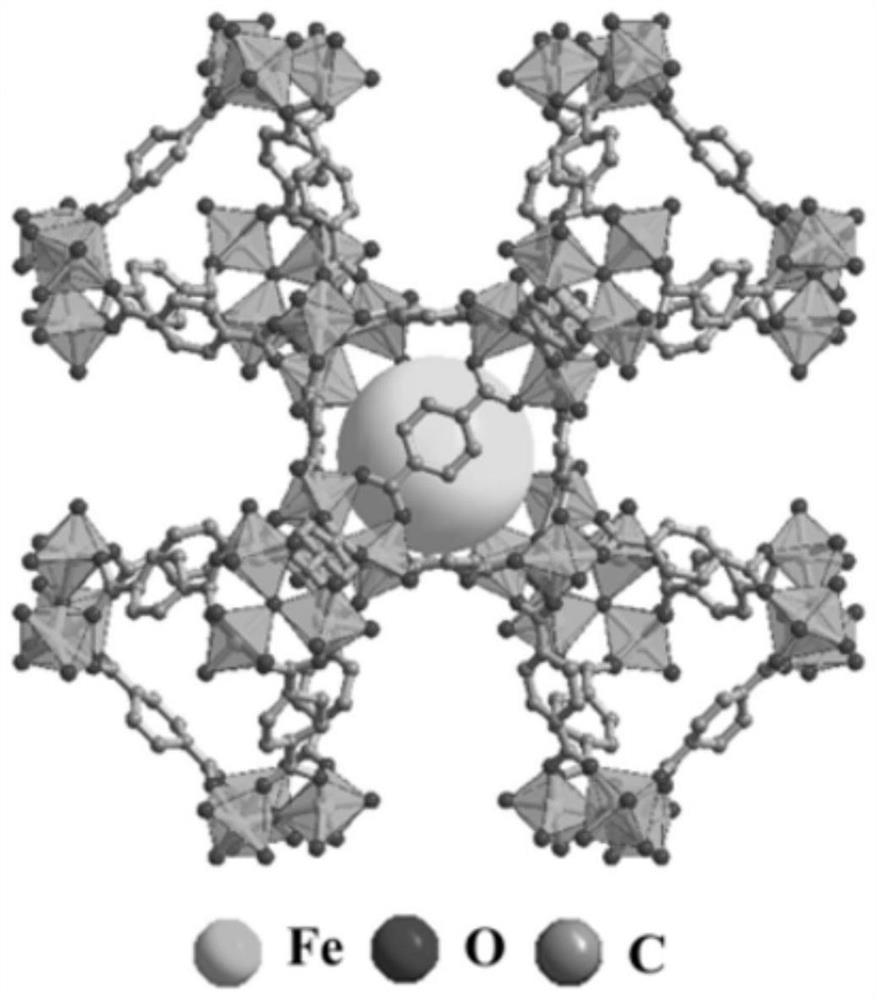A method for detecting bisphenol compounds and their derivatives based on extraction technology of metal organic framework nanomaterials
A metal-organic framework and nanomaterial technology, applied in the detection field, can solve the problems that the adsorbent cannot meet the analysis requirements and the adsorption effect is weak
- Summary
- Abstract
- Description
- Claims
- Application Information
AI Technical Summary
Problems solved by technology
Method used
Image
Examples
Embodiment
[0032] Synthesize NH first 2 -MIL-101(Fe). Add FeCl to 60mL DMF solution 3 ·6H 2 O (19.75mmol, 5.338g) and NH 2 - BDC (10.0 mmol, 1.812 g), the mixture was magnetically stirred for 10 min, then transferred to a stainless steel autoclave with a PTFE liner of 100 mL, and heated at 110° C. for 24 h. After cooling to room temperature, the suspension was transferred to a 100mL plastic centrifuge tube, centrifuged at 7000rpm for 5min to collect a brownish black solid product, which was fully washed with DMF to remove unreacted NH 2 -BDC, washed three times with ultrapure water and ethanol, and finally vacuum-dried at 60 °C for 6 h to obtain activated NH 2 -MIL-101(Fe).
[0033] At 77K liquid nitrogen temperature, through N 2 Adsorption and desorption experiments, analysis of NH 2 - Surface area and pore structure of MIL-101(Fe). NH 2 - N of MIL-101(Fe) 2 The adsorption / desorption isotherm results are as follows figure 2 shown. According to BET and BJH method fitting cal...
Embodiment 2
[0048] The experimental process is as shown in Example 1, except that the amount of extractant is 30 mg, the ultrasonic extraction time is 2.0 min, the elution solvent is 400 μL of methanol, the elution time is 1.0 min, and the pH of the sample is in the range of 2.0-6.0.
[0049] Experimental results:
[0050] The correlation coefficient R of the linear equation of BPs 2 Between 0.9986 and 0.9997; when the signal-to-noise ratio S / N=3, the lowest detection limit is 0.016~0.131μg L -1 ; When the signal-to-noise ratio S / N=10, the quantification limit is 0.05~0.44μg L -1 . The linear ranges of bisphenol compounds and bisphenol derivatives are 0.5~200μg L -1 , 0.25~200μg L -1 .
[0051] In order to detect the stability of the method, the inventors measured the recovery data of the method during the day and within the day, and each detection setting was high (50 μg L -1 ), medium (20μg L -1 ) and low (5μg L -1 ) three concentration levels, the same batch of samples was test...
experiment example
[0053] Experimental reagents: Water samples were collected from different regions in Wenzhou, China. Among them, the river water samples came from the Wenruitang River, the seawater samples came from the coastal area near Yanting Town, Cangnan County, and the tap water samples were collected directly from the laboratory of Wenzhou Medical University. Each water sample was filtered through a 0.45 μm PES filter and stored in a clean glass bottle at 4°C. The above samples were placed at room temperature before use.
[0054] After each type of water sample was grouped, a known amount of BPs was added to the water sample, and the concentration of the standard BPs added was 0, 5 μg L -1 , 20 μg L -1 and 50 μg L -1 .
[0055] Experimental process: The experimental process is as shown in Example 1, the differences are: the amount of extractant is 30 mg, the ultrasonic extraction time is 2.0 min, the elution solvent is 400 μL of methanol, the elution time is 1.0 min, and the pH of ...
PUM
| Property | Measurement | Unit |
|---|---|---|
| volume | aaaaa | aaaaa |
| pore size | aaaaa | aaaaa |
| pore size | aaaaa | aaaaa |
Abstract
Description
Claims
Application Information
 Login to View More
Login to View More - R&D
- Intellectual Property
- Life Sciences
- Materials
- Tech Scout
- Unparalleled Data Quality
- Higher Quality Content
- 60% Fewer Hallucinations
Browse by: Latest US Patents, China's latest patents, Technical Efficacy Thesaurus, Application Domain, Technology Topic, Popular Technical Reports.
© 2025 PatSnap. All rights reserved.Legal|Privacy policy|Modern Slavery Act Transparency Statement|Sitemap|About US| Contact US: help@patsnap.com



